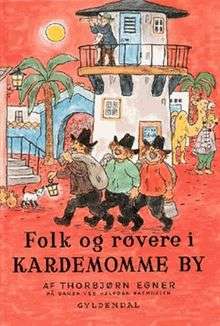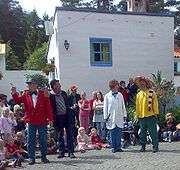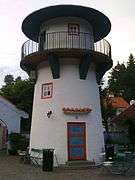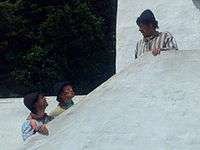When the Robbers Came to Cardamom Town
 First edition | |
| Author | Thorbjørn Egner |
|---|---|
| Original title | Folk og røvere i Kardemomme by |
| Translator | L. Berg & E. Ramsden |
| Illustrator | Thorbjørn Egner |
| Country | Norway |
| Language | Norwegian |
| Genre | Children's novel |
| Publisher | J.W. Cappelens Forlag |
Publication date | 1955 |
Published in English | 1976 |
| Media type | Print (Hardback & Paperback) |
| ISBN | 978-82-02-13977-3 |
| OCLC | 30971127 |
When the Robbers Came to Cardamom Town (Norwegian: Folk og røvere i Kardemomme by) is a 1955 Norwegian children's book written and illustrated by Thorbjørn Egner, which tells the story of Kardemomme by (Cardamom Town). It is considered as one of the most important Norwegian children's books. The book includes many songs which are connected to the story. The story is well adapted for playing as a theatre act with musical elements.
Plot summary
The book is about the peaceful town of Kardemomme and the people there, as well as the only characters which stir up serious trouble. They are the three robbers, Casper, Jasper and Jonathan who live outside the town and regularly enter to steal the things they need. The robbers get arrested and are treated well in jail. In the end they get reformed, and in the final chapter they become the heroes of the day when they extinguish a fire in the tower of the town. Finally Casper becomes the town's fireman, Jasper becomes the town's circus manager and Jonathan becomes the town's baker.
Characters
Main characters
- The Robbers (Casper, Jesper and Jonathan) (Kasper, Jesper og Jonatan) - loud, prone to quarrelling with each other, and live very cluttered. They live in a strange house, with a (kind) lion to protect them.
- Constable Bastian (Politimester Bastian) - the cheerful policeman who is concerned in making sure that everyone is happy.
- Aunt Sophie (Tante Sofie) - a middle aged woman who is the aunt of Kamomilla. Sophie is extremely strict, and the only song she sings is "Aunt Sophies angry song", where she expresses dismay over the horrid state of affairs in the town, and disdain for a number of the people. Regarding Bastian, she sings (A policeman really ought to be a stern and angry man, who goes around arresting people as often as he can). However, Sophie is also a sympathetic character, well ordered and capable of giving some sympathy to those who deserve it.
- Tobias - he is the old wise man in the tower with a long beard. His job is to give the town its weather forecast from the balcony of the tower in which he lives.
Minor characters
- Kamomilla - Aunt Sophie's young niece. She likes to play the piano.
- Tommy - The young son of the town orchestra's Horn player.
- Enoksson the Tram driver - runs the city's tram. He also plays in the city orchestra.
- Simonsson the barber - the town's barber. He also plays the clarinet in the city orchestra.
- The butcher, the baker and the merchant - after they eventually get tired the robbers' robbings, they decide to bust the robbers once and for all.
Theme park
The setting of Kardemomme by was made into part of a theme park in Kristiansand Zoo in 1991. Thorbjørn Egner lived to see the theme park under construction, but not to see it completed.
 The entrance to the Kardemomme by at Kristiansand Zoo
The entrance to the Kardemomme by at Kristiansand Zoo A reenactment of the story in the Kardemomme by
A reenactment of the story in the Kardemomme by The tower of the old wise man Tobias in the Kardemomme by
The tower of the old wise man Tobias in the Kardemomme by The Robbers Kasper, Jesper and Jonathan in the Kardemomme by
The Robbers Kasper, Jesper and Jonathan in the Kardemomme by
Law
Law of Cardamom (Norwegian: Kardemommeloven) is the only law in Cardamom Town. The law is simple and liberal:
- One shall not bother others,
- one shall be nice and kind,
- otherwise one may do as one pleases.
Songs
- Politimester Bastians vise (Constable Bastian's song)
- Visen om været (Song about the weather)
- Trikken i Kardemomme (The tram in Cardemon Town)
- Røvervise (The robbers' song)
- Lille Kamomilla spiller (Little Kamomilla playing)
- Kardemommesangen (The Cardamom song)
- Den talende kamel (The talking camel)
- Tante Sofies sinte vise (Aunt Sophie's angry song)
- Røverfangevise (The capturing of the robbers song)
- Røvernes letevise (The robbers' exploration song)
- Røvernes vise om tante Sofie (The robbers song about Aunt Sophie)
- Sofies sinte vise i røverhuset (Sophie's angry song in the robbers house)
- Røvernes vaskevise (The robbers cleaning song)
- Glade røvere (The happy robbers)
- Hestedans (The horse dance)
- Papegøyen fra Amerika (The parrot from America)
- Hurrasang for Tobias (Hooray song for Tobias)
- Fru Bastians vise (Mrs. Bastian's song)
- Røvernes vaskevise i fengslet (The robbers' cleaning song in prison)
- Barbermestervise (The barber song)
- Hurrasang for røverne (Hooray song for the robbers)
Some of the songs from the book/play were issued on the EP album Kardemommeviser in 1955. The 1975 album Folk og røvere i Kardemomme by (with Egner playing the Jonathan character) was awarded the Spellemann award.
Film adaptation
The book was made into a film in 1988, directed by Bente Erichsen.
Publication history
- First introduced in radio programs for children (Barnetimen for de minste) in 1955
- 1955, Norway, ? (ISBN NA), pub date ? ? 1955, hardback (first edition)
- 1956, play version
- 1976, US, Anchorage Press (ISBN 0876021720), pub date ? December 1976, paperback (first US English ed.) (as People and Robbers of Cardemon Town - L. Berg & E. Ramsden translators)
- 1993, Norway, J W Cappelens Forlag AS (ISBN 978-8202139773), pub date ? ? 1993, paperback (as When the Robbers came to Cardamom Town - Anthony Barnett translator)
References
External links
- IMDB entry for the movie
- Theme park site (in Norwegian)